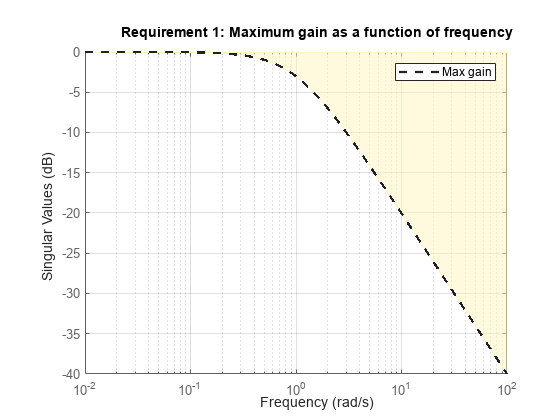TuningGoal.Gain
Gain constraint for control system tuning
Description
Use the TuningGoal.Gain object to specify a
constraint that limits the gain from a specified input to a specified output. Use this tuning
goal for control system tuning with tuning commands such as systune or
looptune.
When you use TuningGoal.Gain, the software attempts to
tune the system so that the gain from the specified input to the specified output does not exceed
the specified value. By default, the constraint is applied with the loop closed. To apply the
constraint to an open-loop response, use the Openings property of the TuningGoal.Gain object.
You can use a gain constraint to:
Enforce a design requirement of disturbance rejection across a particular input/output pair, by constraining the gain to be less than 1
Enforce a custom roll-off rate in a particular frequency band, by specifying a gain profile in that band
Creation
Syntax
Description
Req =
TuningGoal.Gain(inputname,outputname,gainvalue)inputname to
outputname to remain below the value gainvalue.
You can specify the inputname or outputname as
cell arrays (vector-valued signals). If you do so, then the tuning goal constrains the largest
singular value of the transfer matrix from inputname to
outputname. See sigma for more information about singular values.
Req = TuningGoal.Gain(inputname,outputname,gainprofile)frd model.
Input Arguments
Properties
Examples
Tips
This tuning goal imposes an implicit stability constraint on the closed-loop transfer function from
InputtoOutput, evaluated with loops opened at the points identified inOpenings. The dynamics affected by this implicit constraint are the stabilized dynamics for this tuning goal. TheMinDecayandMaxRadiusoptions ofsystuneOptionscontrol the bounds on these implicitly constrained dynamics. If the optimization fails to meet the default bounds, or if the default bounds conflict with other requirements, usesystuneOptionsto change these defaults.
Algorithms
When you tune a control system using a TuningGoal object, the software
converts the tuning goal into a normalized scalar value
f(x), where x is the vector of free
(tunable) parameters in the control system. The software then adjusts the parameter values to
minimize f(x) or to drive
f(x) below 1 if the tuning goal is a hard
constraint.
For TuningGoal.Gain, f(x) is given
by:
or its discrete-time equivalent, for discrete-time tuning. Here,
T(s,x) is the closed-loop transfer
function from Input to Output.
Do and Di
are diagonal matrices with the OutputScaling and
InputScaling property values on the diagonal, respectively. denotes the H∞ norm (see
getPeakGain).
The frequency weighting function WF is the
regularized gain profile, derived from the maximum gain profile you specify. The gains of
WF and 1/MaxGain roughly match
inside the frequency band Focus. WF
is always stable and proper. Because poles of WF close
to s = 0 or s = Inf might lead to poor
numeric conditioning of the systune optimization problem, it is not
recommended to specify maximum gain profiles with very low-frequency or very high-frequency
dynamics.
To obtain WF, use:
WF = getWeight(Req,Ts)
where Req is the tuning goal, and Ts is the sample
time at which you are tuning (Ts = 0 for continuous time). For more
information about regularization and its effects, see Visualize Tuning Goals.
Version History
Introduced in R2011bSee Also
looptune | viewGoal | systune | systune (for slTuner) (Simulink Control Design) | looptune (for slTuner) (Simulink Control Design) | TuningGoal.Tracking | TuningGoal.LoopShape | slTuner (Simulink Control Design) | makeweight (Robust Control Toolbox)

